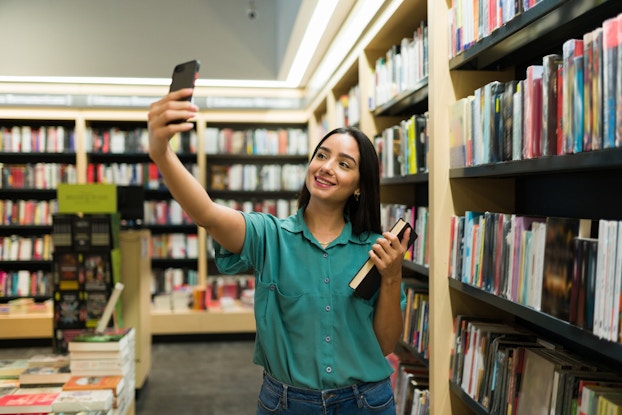
Why it matters:
- U.S. consumers craving community and personalized reading recommendations are gravitating to in-person shopping, buying physical books.
- Print sales rose in 2024 after two years of declines, with unit sales of print books up 1% over 2023 to 782.7 million, according to Publisher’s Weekly.
- To personalize the customer experience and drive sales, bookstores are forming strategic partnerships with local businesses through in-store wine bars, pet adoption events, and even musical performances, for example. They’re also tapping tech and social media to build community around books via digital hubs like Bookstagram, BookTok, and videos of booksellers touting their favorite reads, bookstore owners told CO—.
A few years after Amazon launched its online bookstore in 1995, consumers and publishing industry experts alike predicted the demise of brick-and-mortar bookstores—from indie shops to superstores like Borders and Barnes & Noble.
The lower prices and convenience of getting books delivered directly to your doorstep would shutter physical bookstores, many believed, citing Borders’ 2011 bankruptcy and liquidation as a foreboding sign.


Fast-forward to 2025, and it’s clear doomsayers’ predictions fell short. Barnes & Noble, America’s largest retail bookseller, recently reclaimed its flagship store in the Washington, D.C.’s Georgetown neighborhood after over a decade’s absence. In 2025, the bookstore chain plans to open at least 60 new stores across 17 states, including California, New York, and Texas.
Meanwhile, interest in opening and operating indie bookstores remains strong. Membership in the American Booksellers Association (ABA), which supports independent bookstore owners, stands at 2,433, up 255 from the prior year. Around 192 additional bookstores plan to open in the next few years, the ABA said in its annual report.
“Books have had an interesting ride,” said Elizabeth Lafontaine, Director of Research at Placer.ai, a location analytics company that tracks consumer foot traffic. “They were one of the first to be disrupted by e-commerce, and we thought we’d never see a revival. But now we’re seeing this almost full-circle moment. Consumers are not only visiting bookstores, but they’re also spending more time inside the stores once they’re there.”
For example, Barnes & Noble’s share of visits that last for at least 45 minutes has continued to rise year-over-year, from 24% in 2021 up to 27% in 2024, according to Placer.ai data.
Leaning into a local indie vibe
Indie bookstores are drawing in customers, too. To drive business, bookstores are leaning into a local indie vibe, cultivating social media and tech to build community around physical books, and working to find new, creative ways to personalize and customize the book-buying experience for consumers.
Print sales inched up in 2024 after two years of declines, with unit sales of print books rising by around 1% in 2024 over 2023 to 782.7 million, the first annual increase in three years at outlets that report to Circana BookScan, according to Publisher’s Weekly.
To get customers in to browse, today’s bookstores are laser-focused on cultivating an indie vibe: a cozy atmosphere, connection to the community, and forging a local-hub feel. These types of welcoming places outside work and home are in high demand from consumers post-pandemic, said Lafontaine, and bookstores are a low-cost option.
At Wonderland Books in Bethesda, Maryland, co-owners, long-time friends, and lifelong readers Gayle Weiswasser and Amy Joyce began to create community connections long before opening their doors in December 2024.
To fund the store, they supplemented their own money with an Indiegogo campaign. The roughly $40,000 raised from the community went toward construction and inventory.
Weiswasser and Joyce also launched a founding book club program. For $2,000 each, eight local books clubs got their names printed on the store wall and received store-branded merchandise like tote bags and water bottles. The clubs will get invitations to exclusive events, potentially a book club speed-dating event, during which Wonderland staff recommend book picks based on club members’ interests.
Wonderland actively works to engage the very vibrant communities of readers online in places like Bookstagram on Instagram and BookTok on TikTok. When creating displays, staff consider book influencers who come in, photograph the store, and then post on social media. And book-related videos the store posts on Instagram and Facebook are popular.
“A huge driving force of what we do is build a community behind this bookstore,” Weiswasser said. “We also pay a lot of attention to what people are buying and what they want.”
Wonderland’s local author shelf is small, but growing. The store created a dog wall that features Polaroid pictures of neighborhood dogs taken in-store, and it frequently provides gift cards for school auctions. “It’s all in the service of … making the store a place people want to visit and feel loyal to,” Weiswasser said.
Weiswasser and Joyce participated in an indie bookstore owner boot camp run by bookstore consultant Mark Kaufman and his wife and partner, Donna Paz Kaufman. After learning what it takes to open a bookshop, Weiswasser and Joyce still keep in touch with the few dozen store-owners-to-be in their cohort via a WhatsApp group, sharing advice and working through business challenges.
Kaufman, who also co-founded bookstore Story & Song Center for Arts and Culture in Fernandina Beach, Florida, says the desire to create a sense of belonging is a major driver for his clients. “It’s not home, it’s not work, it’s not church, but it’s a safe space,” he said.
Barnes & Noble is leaning into that trend, too. New and remodeled locations have a “books-first” approach, according to an eMarketer report, and new layouts that feel more like an indie bookstore. Stores are “not just a place that can drive book sales, but a place that can really foster a community of readers,” according to the report.
[Read: Authentic Messaging and Independent Makers Drive Greeting Cards' Next-Gen Relevance]
Drawing customers in through strategic partnerships
At Lovestruck Books in Cambridge, Massachusetts, Rachel Kanter has focused on forming key partnerships to help drive customers to her romance-themed bookstore. Kanter had noticed a rash of closings of local indie businesses, including the beloved Curious George Store. But instead of deterring her, they inspired her to bring indie back.
Kanter envisioned a café and wine bar, but didn’t want to run it. She partnered with coffee entrepreneur George Howell and Founder of George Howell Coffee shops. Kanter and Howell have a management agreement, with a third of the bookstore’s 5,200 square feet dedicated to the café. The café serves a pink sparkling wine cocktail called “The Lovestruck,” and its Red Velvet Latte is only available at Howell’s Lovestruck location.
“What I hear from people over and over again is that we’re just so happy to have a place to gather,” added Kanter.
Lovestruck is partnering with local book clubs, too, giving them space to meet, while creating book clubs of its own. Kanter offers discounts to book club members if they purchase their month’s read from the store.
Meanwhile, Wonderland has done events where they’ve partnered with a local dog rescue to host an in-store adoption event, and also with a school-of-rock-like business, Bach to Rock. Having students perform in the store one Sunday attracted new customers and created goodwill.

Cultivating social media and tech to build community around physical books
Harnessing technology and social media is another key component of bookstores’ growth strategies. Wonderland connected with members of a newly formed audiobook club who now meet at the shop and listen to audiobooks on a nearby trail walk.
Even if they prefer audiobooks, maybe their sister or niece will need a physical book, and they’ll come to Wonderland, Weiswasser said. “We just want them to know we’re here. We don’t view an interaction with a customer that doesn’t end up as a sale as a wasted experience.”
People can also buy audiobooks through the storefront Wonderland set up on Libro.fm, an alternative to Amazon’s Audible. Wonderland gets a commission with every purchase.
Social media is a huge part of the store’s marketing plan, too.
Wonderland actively works to engage the very vibrant communities of readers online in places like Bookstagram on Instagram and BookTok on TikTok. When creating displays, staff consider book influencers who come in, photograph the store, and then post on social media. And book-related videos the store posts on Instagram and Facebook are popular.
Lovestruck’s Kanter outsourced her social media to an outside firm. “That has really paid dividends,” she said, with multiple customers pointing to a TikTok video as their draw to the store. “It’s been huge for business,” she said.
Videos of Lovestruck booksellers talking about their favorite book tend to do well, as do posts of book giveaways.
Since the shop opened in December, its Instagrammable décor, including a massive, colorful flower display outside, has been a draw. “It’s a fun, celebratory space that provides a little bit of escapism, which I think everybody is looking for,” Kanter said. “We have a fair amount of user-generated content now; that takes the pressure off us.”
Bookstores will also make the social media connection by creating prominent displays of books popular on BookTok and TikTok, making it easier for customers who come in to buy books they learned about online.
[Read: 3 Businesses Get Creative to Counter Mounting Customer Acquisition Obstacles—And Win]
Finding new and creative ways to customize the bookstore experience
To make their stores stand out, Wonderland, Lovestruck, and Story & Song spend considerable time curating unique non-book merchandise, too.
At Story & Song, around 50% of revenue comes from books, 20% from non-book sales, 20% from the bistro, and 10% from special events. Its best-selling item is a spinning globe, for which Story & Song has an exclusive license to sell locally.
“With your merch, you really want to be unique,” said Kaufman. “It’s about a sense of discovery, of creating an environment that’s conducive to staying and lingering.”
Lovestruck focuses on romance-related, cozy items to enhance the reading experience, like candles, comfy socks, face masks, slippers, and teas made by local vendors.
“The merch has taken on a life of itself,” she said. “It’s almost half of our sales.” Many of the store’s events are romance-themed, too, like a well-attended author-led workshop on how to plot out a romance novel.
But perhaps the hallmark of brick-and-mortar bookstores is curating an interesting, unique selection of books customers won’t find elsewhere—even online without considerable work—and making personalized recommendations based on the books locals love, says Weiswasser, versus relying on an algorithm to find your next beach read or winter mystery.
“That’s really the value of an independent bookstore,” said Weiswasser. “You come in for that personal service, individual curation, and our point of view.”
CO— aims to bring you inspiration from leading respected experts. However, before making any business decision, you should consult a professional who can advise you based on your individual situation.
Your hard work deserves to be rewarded! Apply for our premier small business awards program, the CO—100, to earn national media attention, get VIP access to premium networking events, and potentially be awarded $25,000! Apply and learn more, here.







